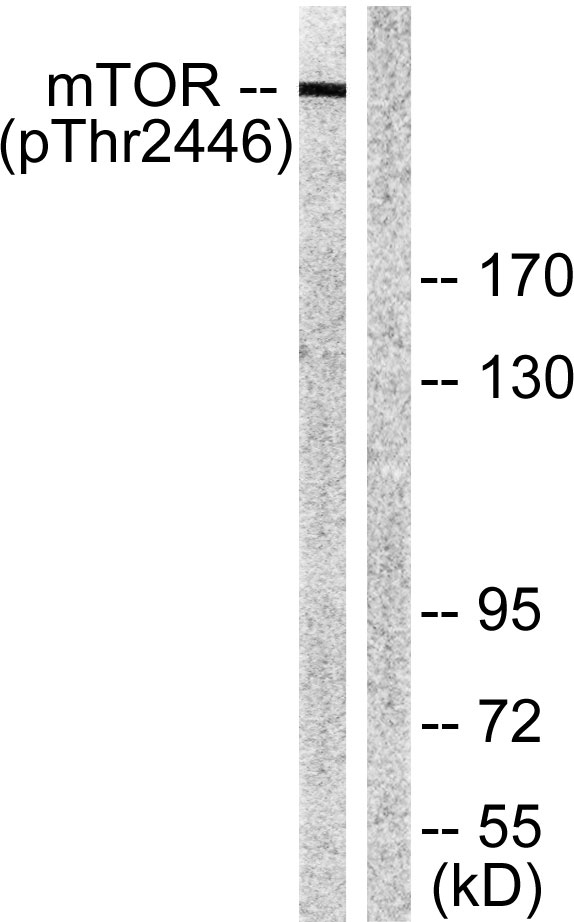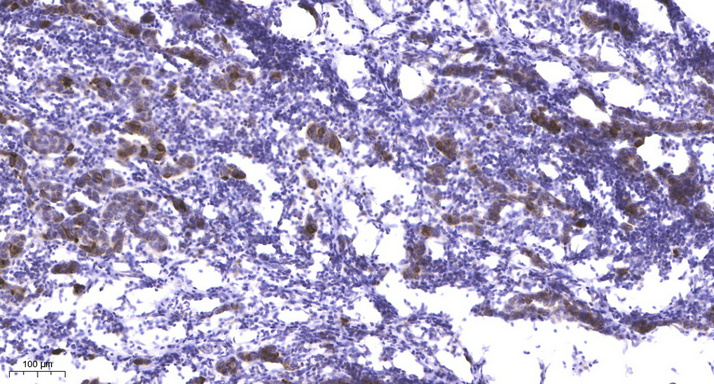mTOR (phospho Thr2446) Polyclonal Antibody
- Catalog No.:YP0384
- Applications:WB;ELISA;IHC
- Reactivity:Human;Mouse;Rat
- Target:
- mTOR
- Fields:
- >>EGFR tyrosine kinase inhibitor resistance;>>Endocrine resistance;>>ErbB signaling pathway;>>HIF-1 signaling pathway;>>Phospholipase D signaling pathway;>>Autophagy - other;>>Autophagy - animal;>>mTOR signaling pathway;>>PI3K-Akt signaling pathway;>>AMPK signaling pathway;>>Longevity regulating pathway;>>Longevity regulating pathway - multiple species;>>Cellular senescence;>>Apelin signaling pathway;>>Neutrophil extracellular trap formation;>>JAK-STAT signaling pathway;>>Th17 cell differentiation;>>Thermogenesis;>>Insulin signaling pathway;>>Thyroid hormone signaling pathway;>>Adipocytokine signaling pathway;>>Type II diabetes mellitus;>>Insulin resistance;>>Growth hormone synthesis, secretion and action;>>Alzheimer disease;>>Amyotrophic lateral sclerosis;>>Huntington disease;>>Spinocerebellar ataxia;>>Pathways of neurodegeneration - multiple diseases;>>Shigellosis;>>Human cytomegalovirus infection;>>Human papillomavirus infection;>>Kaposi sarcoma-associated herpesvirus infection;>>He
- Gene Name:
- MTOR
- Protein Name:
- Serine/threonine-protein kinase mTOR
- Human Gene Id:
- 2475
- Human Swiss Prot No:
- P42345
- Mouse Gene Id:
- 56717
- Mouse Swiss Prot No:
- Q9JLN9
- Rat Gene Id:
- 56718
- Rat Swiss Prot No:
- P42346
- Immunogen:
- The antiserum was produced against synthesized peptide derived from human mTOR around the phosphorylation site of Thr2446. AA range:2412-2461
- Specificity:
- Phospho-mTOR (T2446) Polyclonal Antibody detects endogenous levels of mTOR protein only when phosphorylated at T2446.
- Formulation:
- Liquid in PBS containing 50% glycerol, 0.5% BSA and 0.02% sodium azide.
- Source:
- Polyclonal, Rabbit,IgG
- Dilution:
- WB 1:500-2000;IHC 1:50-300; ELISA 2000-20000
- Purification:
- The antibody was affinity-purified from rabbit antiserum by affinity-chromatography using epitope-specific immunogen.
- Concentration:
- 1 mg/ml
- Storage Stability:
- -15°C to -25°C/1 year(Do not lower than -25°C)
- Other Name:
- MTOR;FRAP;FRAP1;FRAP2;RAFT1;RAPT1;Serine/threonine-protein kinase mTOR;FK506-binding protein 12-rapamycin complex-associated protein 1;FKBP12-rapamycin complex-associated protein;Mammalian target of rapamycin;mTOR;Mechanistic tar
- Observed Band(KD):
- 220kD
- Background:
- The protein encoded by this gene belongs to a family of phosphatidylinositol kinase-related kinases. These kinases mediate cellular responses to stresses such as DNA damage and nutrient deprivation. This protein acts as the target for the cell-cycle arrest and immunosuppressive effects of the FKBP12-rapamycin complex. The ANGPTL7 gene is located in an intron of this gene. [provided by RefSeq, Sep 2008],
- Function:
- function:Acts as the target for the cell-cycle arrest and immunosuppressive effects of the FKBP12-rapamycin complex. Part of the TORC2 complex which plays a critical role in AKT1 Ser-473 phosphorylation, and may modulate the phosphorylation of PKCA and regulate actin cytoskeleton organization.,similarity:Belongs to the PI3/PI4-kinase family.,similarity:Contains 1 FAT domain.,similarity:Contains 1 FATC domain.,similarity:Contains 1 PI3K/PI4K domain.,similarity:Contains 7 HEAT repeats.,subunit:Interacts with the FKBP12-rapamycin complex. Binds UBQLN1. Forms part of the mammalian target of rapamycin 2 complex (TORC2) comprised of FRAP1, GBL, PRR5, RICTOR and SIN. TORC2 does not bind to and is not sensitive to FKBP12-rapamycin. Binds directly to PRR5 and RICTOR within the TORC2 complex.,tissue specificity:Expressed in numerous tissues, with highest levels in testis.,
- Subcellular Location:
- Endoplasmic reticulum membrane ; Peripheral membrane protein ; Cytoplasmic side . Golgi apparatus membrane ; Peripheral membrane protein ; Cytoplasmic side . Mitochondrion outer membrane ; Peripheral membrane protein ; Cytoplasmic side . Lysosome . Cytoplasm . Nucleus, PML body . Microsome membrane . Lysosome membrane . Cytoplasmic vesicle, phagosome . Shuttles between cytoplasm and nucleus. Accumulates in the nucleus in response to hypoxia (By similarity). Targeting to lysosomes depends on amino acid availability and RRAGA and RRAGB (PubMed:18497260, PubMed:20381137). Lysosome targeting also depends on interaction with MEAK7. Translocates to the lysosome membrane in the presence of TM4SF5 (PubMed:30956113). .
- Expression:
- Expressed in numerous tissues, with highest levels in testis.
- June 19-2018
- WESTERN IMMUNOBLOTTING PROTOCOL
- June 19-2018
- IMMUNOHISTOCHEMISTRY-PARAFFIN PROTOCOL
- June 19-2018
- IMMUNOFLUORESCENCE PROTOCOL
- September 08-2020
- FLOW-CYTOMEYRT-PROTOCOL
- May 20-2022
- Cell-Based ELISA│解您多样本WB检测之困扰
- July 13-2018
- CELL-BASED-ELISA-PROTOCOL-FOR-ACETYL-PROTEIN
- July 13-2018
- CELL-BASED-ELISA-PROTOCOL-FOR-PHOSPHO-PROTEIN
- July 13-2018
- Antibody-FAQs
- Products Images

- Western Blot analysis of various cells using Phospho-mTOR (T2446) Polyclonal Antibody diluted at 1:1000

- Enzyme-Linked Immunosorbent Assay (Phospho-ELISA) for Immunogen Phosphopeptide (Phospho-left) and Non-Phosphopeptide (Phospho-right), using mTOR (Phospho-Thr2446) Antibody

- Western blot analysis of lysates from NIH/3T3 cells treated with Insulin 0.01U/ml 15', using mTOR (Phospho-Thr2446) Antibody. The lane on the right is blocked with the phospho peptide.

- Immunohistochemical analysis of paraffin-embedded human Breast cancer. 1, Antibody was diluted at 1:200(4° overnight). 2, Tris-EDTA,pH9.0 was used for antigen retrieval. 3,Secondary antibody was diluted at 1:200(room temperature, 45min).



